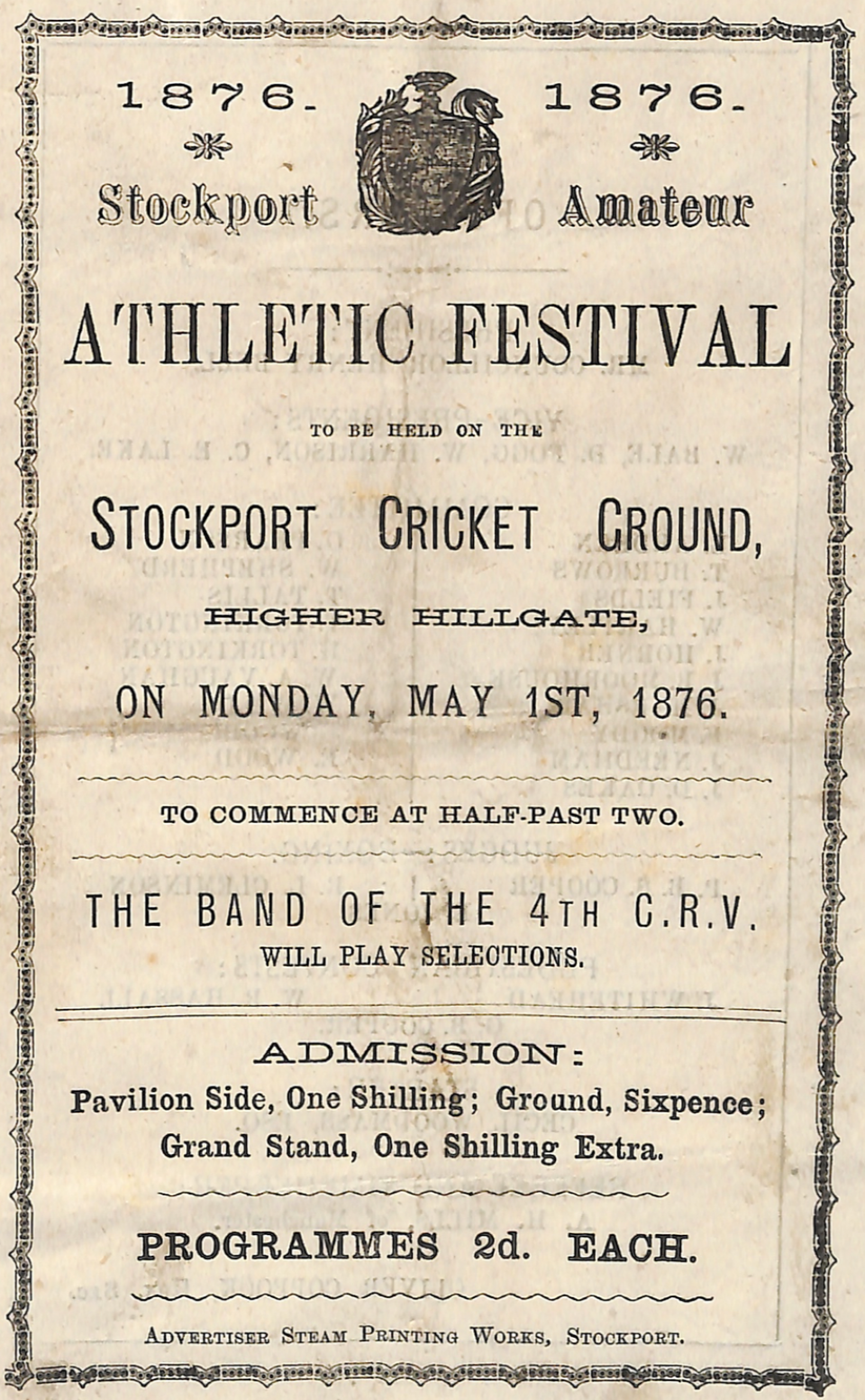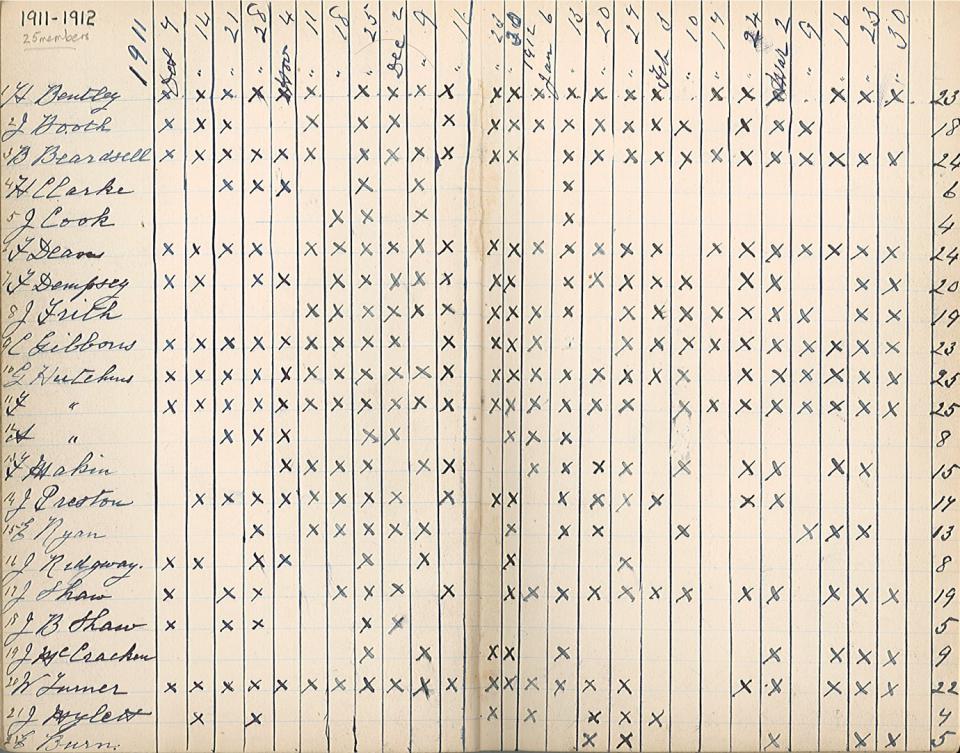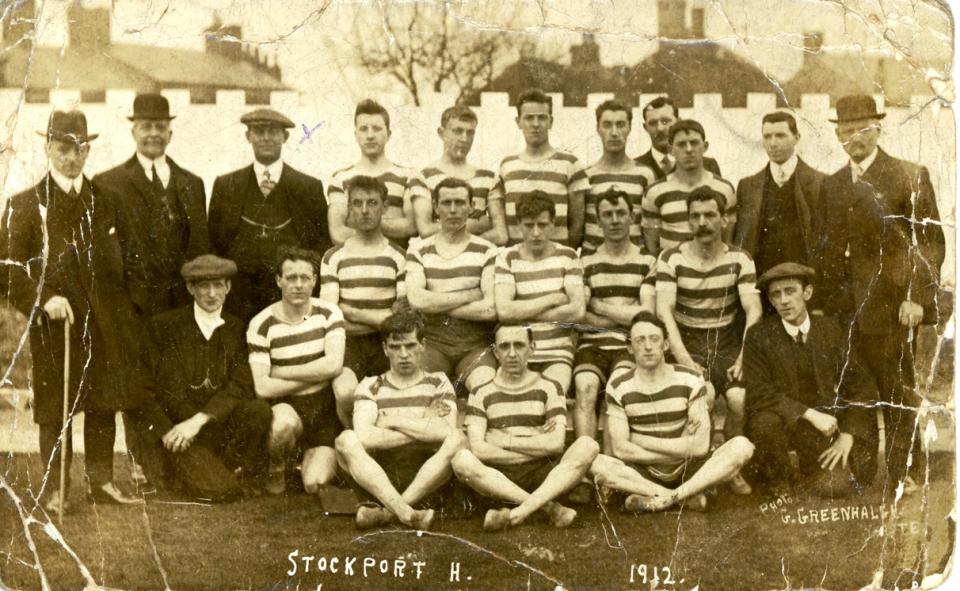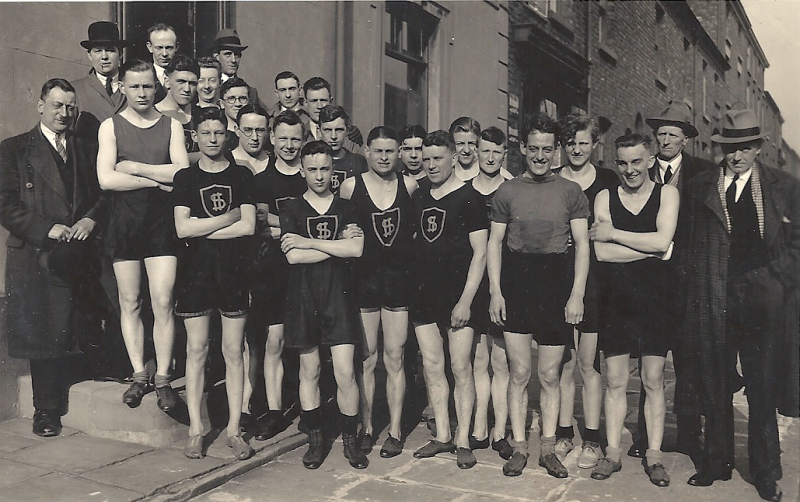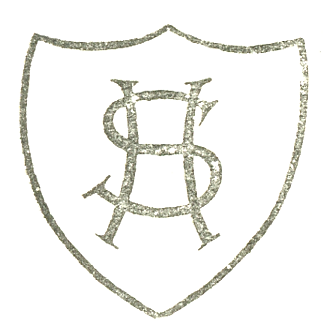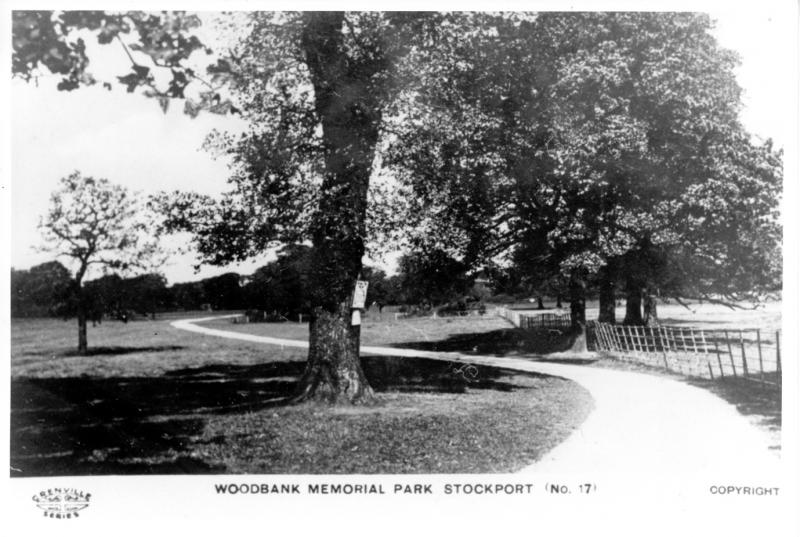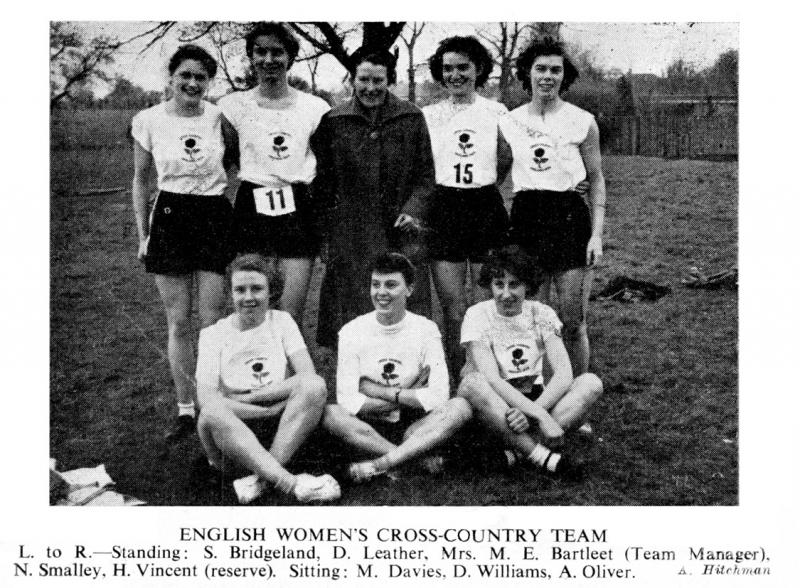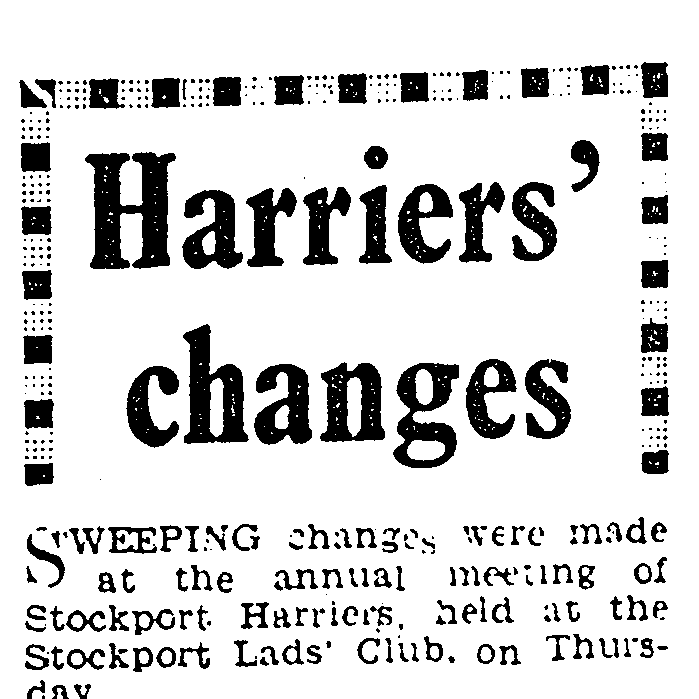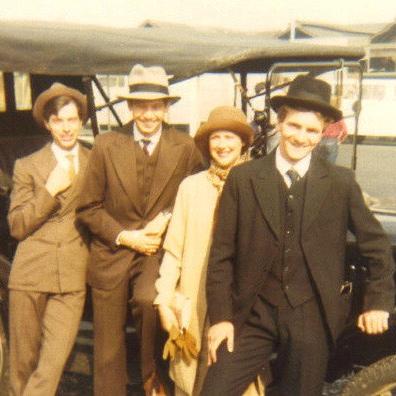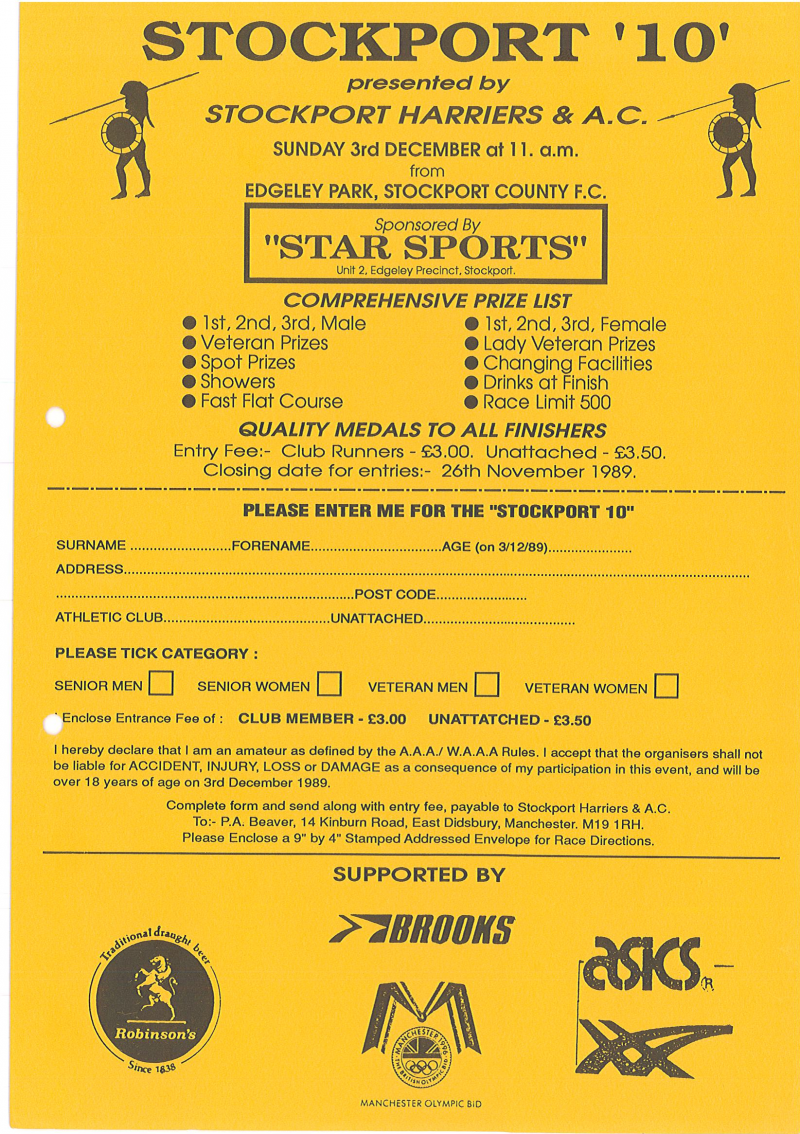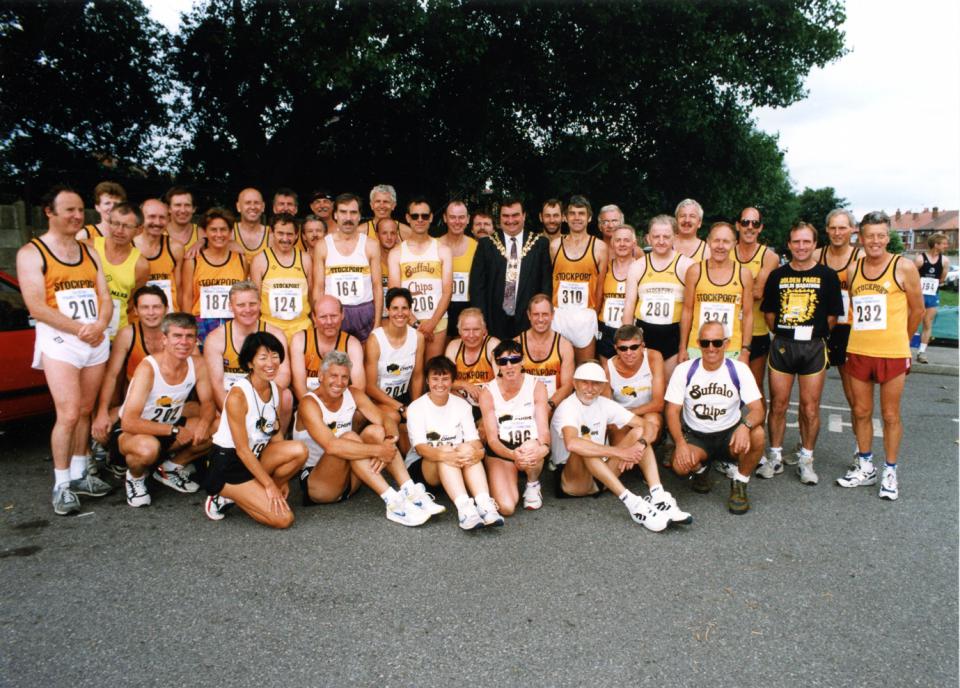The mid-nineteenth century saw a rapid increase in interest in athletics throughout England and the Greater Manchester area was no exception. Local papers report numerous athletic events and races, and the first athletics clubs began to emerge across the region.
In August 1872, the Manchester Evening News reported news of the Stockport Athletic Festival, held on the cricket ground, and included a one-mile flat race, ‘throwing the cricket ball’ and ‘pole leaping’. Prizes totalling £100, a princely sum, were offered. The flyer below is for a similar event held in May 1876.
In 1887, the Davenport Harriers, which would later become Stockport Harriers, was established. Why the name Harriers? When athletics emerged in the 1860s and 1870s, paper-chasing became popular after its introduction on by Thames Hare & Hounds on Wimbledon Common in 1868. In a paper-chase, two 'hares' lay a trail of paper over the country, and the pack of 'hounds' try to catch up with them. Although this sport soon developed into cross country as we know it today, the earliest such clubs called themselves 'Hare and Hounds' or 'Harriers', and still do.
The Athletic Journal reported that the 20 members who turned out for one of Davenport’s first weekly runs. And the Stockport Advertiser said that the group divided into ‘hares’ and ‘hounds’ for the 5-mile run through Bramall, Cheadle Hulme and Adswood Lane and back to the starting point on Davenport Crescent. The runners then ‘adjourned to the house of Mr Shaw, one of the vice-presidents, ’where they were entertained to tea, followed by a social.’
In July 1891, Stockport Harriers were first mentioned in the Stockport Advertiser, which reported that the AGM of the Davenport Harriers agreed to change its name to Stockport Harriers. There was concern that if another club was established with the Stockport name, it would get more public support with better prizes and lure away the better runners. Later that year, the re-named club published a list of over 20 fixtures for the season from October 1891 to April 1892, with the season’s closing run to be held at the club’s Adswood Inn HQ. Apart from fixtures against rival clubs, some of the club runs were arranged at various meeting points throughout the borough including Hazel Grove, Cheadle, Heaton Norris and Disley.
There are numerous newspaper reports of events organised by Stockport Harriers or in which club members took part from 1892 up to 1903. However, from 1904 until 1911, there are no reports about the Club nor any meeting minutes, so the Club was probably inactive during much of the first decade of the 20th century.
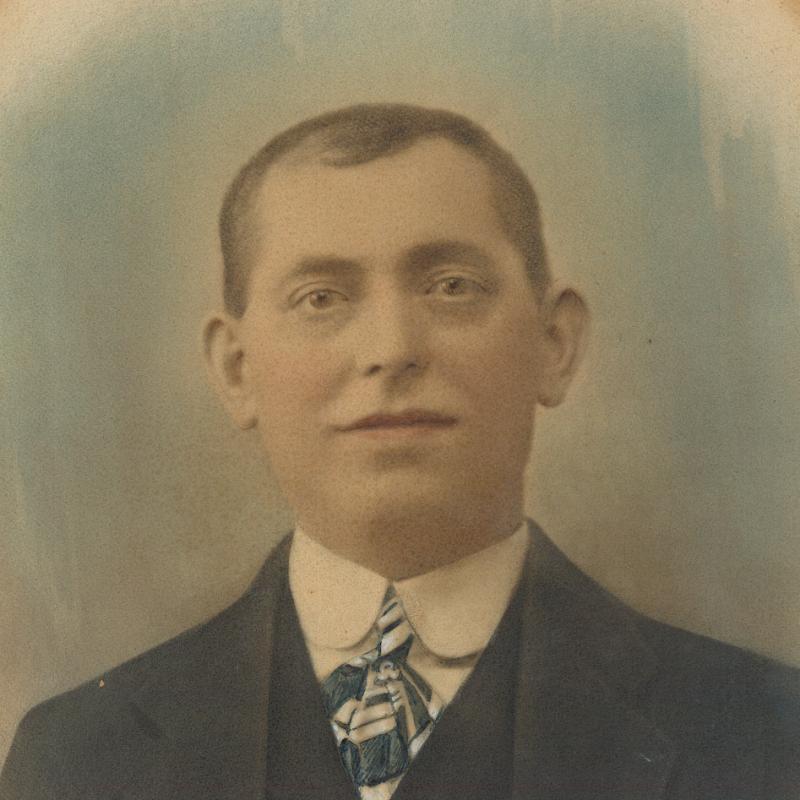
The sport continued its growth and in 1911, Stockport Harriers along with the Reddish Harriers & Marple Harriers merged to become a reorganised Stockport Harriers. Its first AGM was held at the Egerton Arms, St Petersgate, Stockport on 22 Sept 1911 and on Sat 30th, the club held a race meeting with distances of 300 yds and one-mile handicap, ‘open to paid-up members only.’ The re-formed Club’s first President was Mr Tom Wilson shown above. Club Officers in this era, other than Captains, were not typically athletes themselves.
Club members took part in regular cross-country races including a 7-mile handicap just before Christmas 1914, which started and finished at the Finger Post Hotel in Offerton, which was surrounded by fields at that time. There are no news reports of races during the remainder of the First World War. The Stockport Express reported on 17 Oct 1919 that Stockport Harriers held its first cross country run from the Royal Oak Hotel, Hazel Grove since the club closed at the start of the war.
By the winter of 1920-21, the Club was participating in the East Lancs Cross-Country Association. The ELCCA Championships, held at Manchester Racecourse on 5 Feb 1921, included a 9-mile Senior Race, and shorter distances for Junior (later re-named Second Division) and Youth (under 18) Teams. The conditions must have been brutal as only 18 of the 51 senior starters finished the race, which was won by Mr G Wallach of Broughton H&AC in just 53.28!
During this period only the top clubs in area championships qualified to participate in the Northern Cross-Country championships. In 1921, the Club won the ELCCA Junior Championships, in 1923 the Senior Championships and in 1929 the Youth Championships. The nine-mile senior course in this era was one and a half miles longer than the championship distance today for both the Northerns and Nationals.
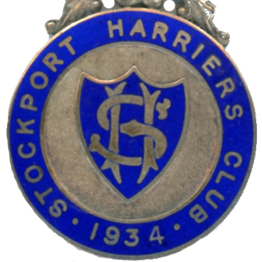
The period before WWII was before the era when athletics had become a mass participation support. The finishers medals now commonplace at large road races were non-existent; however, gold, silver and bronze medals were often awarded to the first three finishers in championship races, like the gold medal shown below, awarded in 1934.
The 1932 Member’s Book gives some great insights into the Stockport Harriers of the 1930s. Apart from the Club HQ at the Rising Sun Hotel in Hazel Grove, there were 3 branches at the Scout’s Hall, Alderley Edge; White Horse Hotel, Disley; and the Talbot Hotel, Macclesfield. The Club President was Councillor JH Stansfield and it had 8 Vice Presidents, a Captain and Sub-Captains, a Secretary/Treasurer and 3 Branch Secretaries. There were 13 Club Fixtures between October and December as well as a number of League XC races and Championship Races each year. The Club Colours were: ‘Black Pants and Vest, with Amber Badge.’
The Woodbank Estate, which is now Woodbank Park, was in private ownership until 1921 when it was purchased by Sir Thomas Rowbotham. He gave the hall and 89 acres to the town as a memorial to those who had been killed during World War I. He had originally intended the Hall to be used as an infirmary, but when that offer hadn’t been taken up within a year, he withdrew it and donated the mansion and grounds to the Stockport Corporation.
In 1946 Stockport Harriers moved their base to the now demolished stables at Woodbank Park. Then in 1951, an agreement was made for the construction of a sports field, running track, jumping pits, ‘dressing accommodation’ and entrance gates at the King Goerge V Memorial Playing Fields, later to become Woodbank Stadium. The work was completed in 1952.
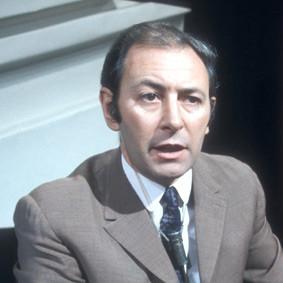
In 1949, working as a reporter on the Stockport Express the then 23-year-old David Coleman won the prestigious Manchester Mile event at Fallowfield Stadium as a Harrier, in 4.16. David Robert Coleman OBE went on to become a sports commentator and television presenter who worked for the BBC for 46 years. He covered eleven Summer Olympic Games from 1960 to 2000 and six FIFA World Cups from 1962 to 1982.
An article in the Stockport Express in Dec 1950 described one of Coleman’s successes as a Harrier:
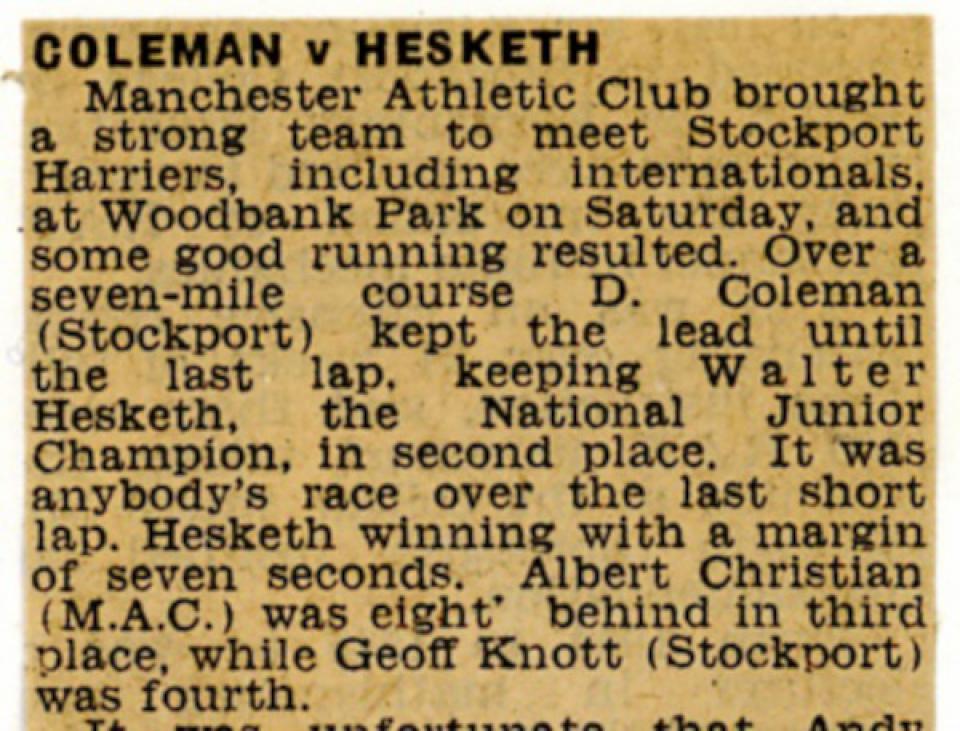
The Club’s Women’s Section was formed in 1950 and in that year at least 16 women were members and competed for the Club. The star performer of that era was Marion Forbes (nee Davies), who joined the Club in 1951, age 17. The Athletic Review featured her in their Stars of Tomorrow column where she was described as “one of the North’s brightest hopes in distance events, who is well equipped to tackle any distance from 440 yds to the regulation cross country events.” In the National XC Seniors at Birmingham, she finished 2nd to Diana Leathers, and was selected for the English Women’s XC Team in 1954. She married her Coach, Stuart Forbes, at Hazel Grove Methodist Church in August 1963.
From its foundation in 1911 until April 1959, the club was known as Stockport Harriers. From this date, the name was changed to Stockport Harriers & AC, reflecting increasing interest in track and field events. The men and women’s sections functioned independently, and the new club colours were a yellow vest, trimmed with black and black shorts, trimmed with yellow.
During the mid-1960s, the Club fell into the doldrums and at the end of the decade there were only a few dozen members. For many years, the Club attended other Clubs’ fixtures, County Championships and the Manchester Cross Country League and put on no events itself. At the 1969 AGM, the turnaround began. John Lahan was elected President and his daughter Christine, now Thompson, was elected Secretary, the Club’s first female officer. The Club let the media know that it was serious about re-kindling the enthusiasm that had once existed for Stockport Harriers. Over the winter of 1969-70, Chris and a group of others re-vitalised the Club’s “Ladies Section” and many girls and young women joined. Following their example, other area clubs started Ladies Sections. Chris started a Girls Schools League, called ‘6 over 6’, which became an instant success. Walking Races were initiated in 1972, and members qualified as race officials.
The Club put on its first track meeting in years in 1973, which other clubs attended, and entered a Senior Team take part in the Northern League Division 4. In 1975, the Olympic Champion Mary Peters accepted the Club’s invitation to become a Life Vice President. By this time, membership had risen to about 250, however senior members were scarce and were outnumbered by juniors. Later that year, Syd Smith, age 65, went to Canada where he took part in the Veterans Olympics, winning two gold medals. John Lahan was elected Life Vice President in 1975 for his leadership role in revitalising the Club.
From 1972 to 1997, Race Walking was one the Harriers’ core events. In the 1972 Cheshire Championships, Len Mullen won the Bronze Medal in the 15km Road Walk at Woodbank Park. Members took part in the 55th Annual Manchester to Blackpool Race Walk with Tony Malone finishing 3rd in 8 hours 41 minutes. Vanessa Chappell was a top race walker who took part in nearly 60 races from 1980 to 1983, mainly at 3000 & 5000m, though she also took part in 10k and 20k events. The final race that Stockport athletes appear to have taken part in was the North of England AA Men’s 50k and Women’s 20k Championships, held at Woodbank Park in 1997.
The use of the Leonidas image in the Club logo dates to the mid-1970s, when the then Club Captain Len Mullen brought back a trophy from a Greek holiday, and it was awarded annually to the club personality of the year, becoming part of the Club logo. The warrior hero Leonidas led the allied Greek forces to a last stand at the Battle of Thermopylae (480 BC) while attempting to defend the pass from the invading Persian army. He died at the battle and entered myth as the leader of the 300 Spartans.
Chariots of Fire is the 1981 Oscar-winning historical athletics film based on the true story of two British athletes in the 1924 Olympics: Eric Liddell, a devout Scottish Christian who runs for the glory of God, and Harold Abrahams, an English Jew who runs to overcome prejudice. Len Mullen was the former Track & Field captain for Stockport Harriers as well as a past Cheshire County 1,500m Champion. Together with two other Stockport Harriers he appeared as an extra in Chariots of Fire. He can be seen running in the iconic opening scene on the beach at St Andrews, Scotland with fellow Harrier Graham Brooke. Len is in the centre of the photo.
Lesley Tivey, a proficient middle-distance runner in her youth, was the third SHAC member who appeared in many of the crowd scenes during the making of the film.
In 1984, following a visit to the Club by Jan Jullicher, an employee of Phillips who was working locally in Hazel Grove and joined the Club for a year. SHAC, under the guidance of Peter Powell, began a series of running trips to various European countries over the next 30 years, including Austria, Germany and The Netherlands, where members competed in both marathons and shorter distance races. Former Club Treasurer John Wharf organised several similar trips to Norway and Sweden during the same period.
In 1987 an all-weather synthetic track was laid after members of Stockport Harriers and Manchester Harriers & Athletic Club formed the Stockport Athletic Track Appeal. (S.A.T.A.) which successfully campaigned for the £330,000 funding needed to upgrade the cinder track to today’s synthetic track.
The Stockport 10 and Offerton 10k (now the Offerton 5-mile Multi-Terrain Race) trace their origins back to the 1980s. The first of what would eventually become the Offerton 10k and now the Offerton 5, was held on Wed 1 July 1987, and was a 6-mile road race called the Offerton Drakes Armada 6. First male was M Peters of Salford in 29.35 and the first female was Susan Simpkin of Middleton in 34.21. Rob Taylor (Stockport), David Gee (Manchester) and Paul Light (Buxton) who all continue to race today, were all in the top 10. The current record holders of the Offerton 5 Multi-terrain Race are Steve Vernon of Stockport Harriers in 27.39 (2021) and Alice Davies of Stockport Harriers in 35.24 (2021).
The Stockport 10 Road Race was first held in 1989 on Sun 3 Dec with a bargain entry fee of £3 for attached runners. That race was held at Edgeley Park, Stockport. The first three males were all Harriers and 1st was Tony Okell in 50.55 and a total of 69 finishers ran under 60 minutes!
In 1994, The Stockport 10 was moved to Avondale Recreation Centre in Edgeley, and in 1997 to its current HQ at Woodbank Stadium. The course was re-designed in 2014 and in the intervening years, the race has often attracted well over 1,000 starters. In 2020, due to the Covid-19 pandemic, a virtual version of the race saw 158 runners taking part. The current course record holders are Jonny Mellor of Liverpool Harriers in 49.23 (2019) and Alison Lavender of Oswestry in 58.12 (2014).
In 1993 the Club twinned with Buffalo Chips Running Club, based in Sacramento, CA USA. The ‘Chips’ were introduced to SHAC by Professor George Parrott of the University of Sacramento and his late partner Christine during a sabbatical year spent at Manchester Metropolitan University 1992-93. He trained with SHAC while living in Cheadle Hulme, which led to the Harriers ‘twinning’ with the Buffalo Chips. This was followed by several athletics exchange visits for. A major mover for the Harriers was Phil McCann who has since retired from athletics.
The first parkrun at Bushy, London in 2004, led to an increase in mass participation in running in the UK. By 2021, there were 729 parkruns across the UK as well as another 1,300 in 22 other countries. SHAC members were actively involved in organising one of the earliest parkruns, at Woodbank Park in August 2009 and in the following 12 years, over 395 different SHAC members have completed over 10,000 parkruns at Woodbank. While it is hard to know for certain, parkrun participation has led to well over a hundred new SHAC members during this period, including entire families.
In March 2014, Harriers announced a merger with Dash AC, a club primarily of juniors competing in track and field events, which brought an additional 200 members to the Club. While there were several dissenting voices at the EGM, which approved the merger, the majority felt that the Club would benefit from both additional coaching expertise as well as an increase in juniors interested in track and field competition.
In 2014, former Club Chair Barry Thompson, started a campaign with his wife, Christine (nee Lahan), to raise £150,000 for The Christie, Manchester’s world-class cancer treatment hospital, in recognition of the care and treatment received by Chris during two separate bouts with cancer. Barry has been a club member for 43 years and Chris was elected the Club’s first female Club Secretary, in 1969. In the first phase of the campaign, many club members ran the 2014 Manchester Marathon to raise money for Barry’s 150 campaign. The campaign vastly exceeded its target, raising over £282k for The Christie. In recognition of his efforts, Barry was made Ambassador of the hospital’s Young Oncology Unit. Chris and Barry plan to re-start their fundraising in 2022 with a focus on local schools.
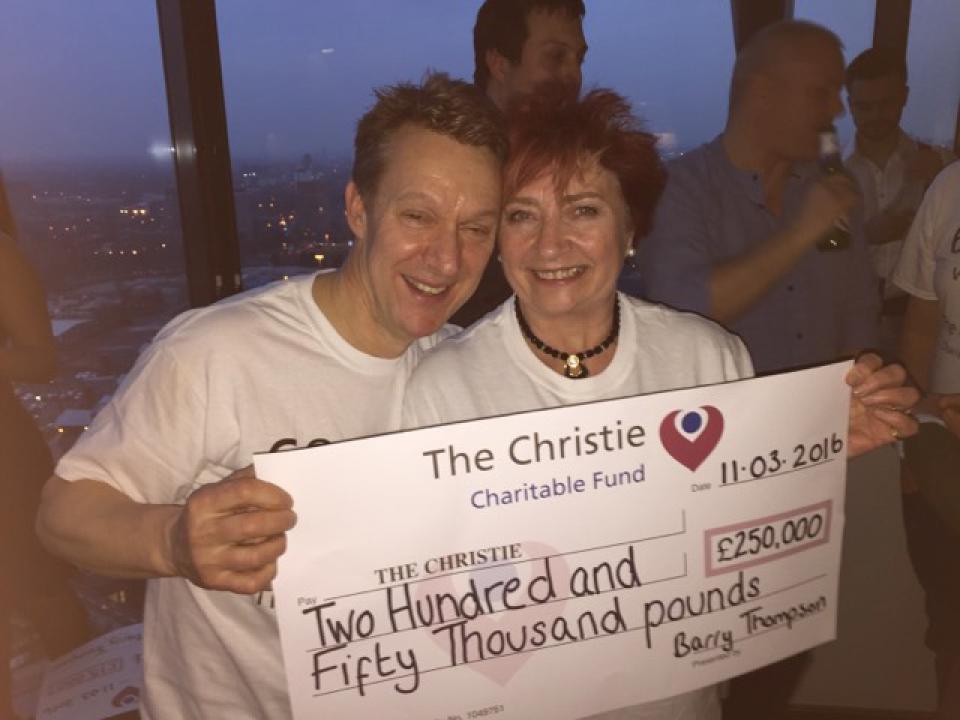
The organisers of the 2014 Great Manchester 10k Run, awarded a trip to the Great Ethiopia Run to the Club with best performing mixed team in the event (7 men & 7 women) and the SHAC team came first that year. A team including Charlie Batho, Ade Nutter, Pat Martin, Rob Goulsbra, Jay Wood, Dean Matkin, Jenny Knass, Ruth Sinclair, Jayne Lawton, Mollie Williams, Faye Waterhouse, Amie Hughes, and Alison Duckworth travelled to Ethiopia. Their training runs in Addis Ababa were accompanied by Kenesisa Bekele, Julia Bleasdale and Alistair Brownlee and they had a post-race barbeque at the home of marathon great, Haile Gebrselassie.
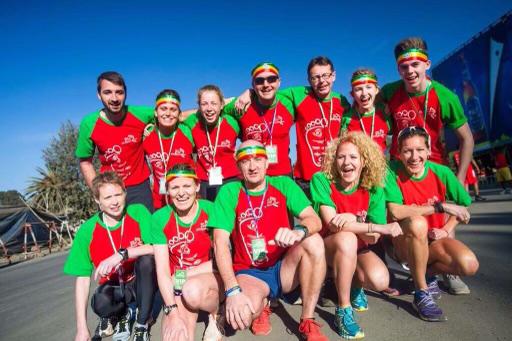
In Oct 2018 a dream team of 6 Harriers, including Jack Martin, Jack Morris, Steve Vernon, Andrew Davies, Patrick Martin and Ross Millington won the ERRA National Road Relay in Sutton Park, Birmingham with a margin of just 25 seconds over Leeds City.
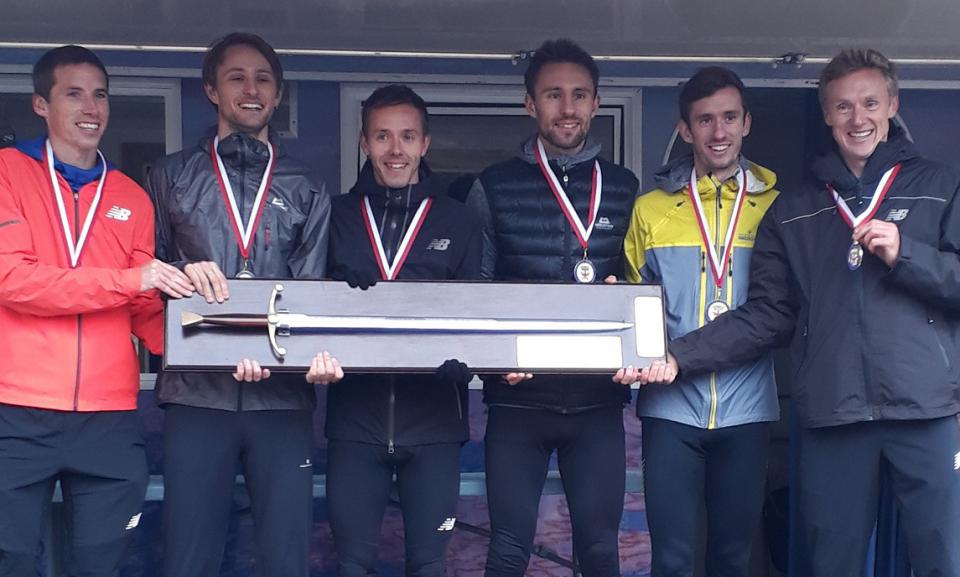
Credits: Archives of Hamish Thomson, Stockport Advertiser, Stockport Express, Manchester Evening News, Athletics Review, Athletics Journal, UK Athletics, BMAF, Mark Shearman, Pete Brown Photography.
